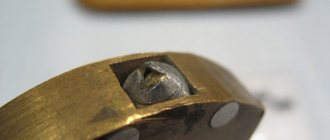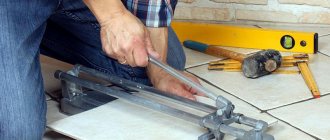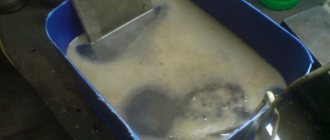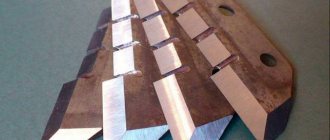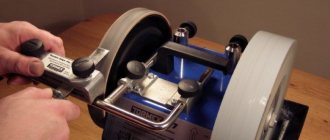Sooner or later, a household may need to replace glass on its own. But working with such fragile material is very dangerous. Therefore, in order to avoid injuries and unnecessary consumption of material, you should know the basic rules for working with this material and the selected tool.
Cutting ordinary glass is very simple and will not cause any difficulties for a person. You can cut such glass with a special glass cutter or even ordinary scissors.
If you have no idea how to properly handle this tool, you can watch numerous videos on this topic on our website. They will help you cut out the desired shape and provide the necessary information on working with a rather complex and fragile material like glass.
Safety regulations
When starting the procedure for cutting glass, be sure to keep in mind that working with this material requires compliance with safety rules, which are not recommended to be neglected. When untreated, glass has sharp edges that can easily cut the skin and cause infection. To avoid cuts, protect your hands with gloves and wear clothes with sleeves. Since glass tends to crumble into small, sharp fragments, we strongly recommend cutting with glasses.
The glass cutting area must be level and stable. It is strictly not recommended to perform this operation on a knee, a rickety stool, or other questionable surfaces. Compliance with this rule will minimize the risk of glass falling onto the floor, and will also make the work more convenient and improve the quality of the cut.
If you have not previously had experience in handling glass, and do not yet know how to cut with a glass cutter, we do not recommend neglecting the above recommendations. Perhaps some experienced craftsmen can do this work with their eyes closed on their knees, but for beginners everything usually does not go so smoothly. Due to inexperience, you can make many mistakes: grab a sharp edge, drop the glass on your foot, or crush the cut site and get a piece of glass in your eye. If you are working with glass for the first time, and have not yet experienced this process, it is best to be fully prepared.
Glass selection
One of the key factors for the success of any job is choosing the right material. This belief also applies to glass, which should be selected based on the task at hand. In the following paragraphs, we will give a couple of recommendations on how to determine the quality of glass and choose the optimal thickness. If you already have the material, you can go to the next heading or directly to the instructions on how to cut glass with a glass cutter.
Before we begin the description, we clarify that we are talking about ordinary window glass, which is most common in the construction markets. The first thing you need to pay attention to when buying glass is its end part. The edge of the canvas should have a bluish-green tint. Low quality glass has greener tones due to the higher iron content. This material is more fragile, but usually costs less.
The choice of glass thickness should be made based on the required dimensions. To make working with the canvas more convenient and to minimize the risk of defects, the ratio of width, height and depth should be optimal. Glass with an area of 1 m² and a thickness of only 2 mm is highly likely to crack at the first wrong movement. When using canvases up to 50 cm, a thickness of 2-2.5 mm will be sufficient. From 50 to 100 – 3-4 mm. More impressive sizes should have a thickness of 5-6 mm or more. Take these recommendations into account when choosing glass in a store and save yourself from unnecessary trouble.
Preparatory activities
In order for the cut to be of high quality, it is necessary to first prepare the material for work. If the glass is new, then just wipe it. Newspaper is best suited for these purposes; it mainly wipes the surface dry and also does not leave lint or stains behind.
If the glass has been used before, then before cutting the material with a glass cutter, you will need to spend a little more time preparing it. First of all, such a surface will need to be washed thoroughly using special glass cleaning products. A thorough degreasing process should then be carried out. Alternatively, you can use kerosene. To do this, use a rag soaked in kerosene to thoroughly wipe the glass and wait until it dries completely.
At the same time, the glass preparation stage also includes cutting it. There is no doubt that you will be able to achieve the final result without waste, especially if you need to cut a product of irregular geometric shape. But if you make the calculation as correctly as possible, you can reduce the amount of waste several times.
Also, make sure that the working surface is fairly flat and without slopes, but not too hard; it is advisable to make the working surface from plywood or fiberboard, and cover the top with oilcloth or soft cloth.
Preparing for work
Cutting glass with a glass cutter is a responsible task that requires some preparation. It is necessary to prepare the place where cutting will be carried out, and the material itself that will be subjected to it:
- The surface on which the sheet of glass should lie must be perfectly flat. During cutting, significant pressure is applied to the glass. If somewhere there is an unevenness, a dip or a difference in height, the glass may simply crack in an unpredictable place, and the crack will be branched and ruin the entire workpiece.
- It is better not to place glass directly on a metal or wooden surface, as they may scratch each other, and the glass may slip or move. Lay a piece of fabric, thick film or rubber - this will soften the surface and improve grip.
- The glass surface must be clean. For minor stains, rinse with water and wipe dry. Use paper towels or old newspapers for this so as not to leave lint on the glass. Remove heavy stains with kerosene, white spirit or acetone.
How to cut glass with a glass cutter: detailed instructions
If you are planning to cut glass, then first of all you should decide which glass cutter is best suited for your case. At the moment, there are two types of tools - diamond and roller.
How to cut glass at home
The diamond model is rightfully considered the leader among tools of this type. If you are going to use it at home, then the perfect model is one that has a beveled edge, which is very convenient for breaking off cut pieces. You can cut glass with such a glass cutter, almost ten kilometers of material, with a thickness of up to one centimeter. But at the same time, it should be taken into account that there are also cheap types in which an artificial diamond is installed, which allows cutting glass with a thickness not exceeding 5 mm.
Unlike a diamond cutter, a roller glass cutter has a working element in the form of a small roller, usually made of carbide materials, usually a tungsten-cobalt alloy, which is capable of cutting material up to 4 mm thick. The advantage of this type of tool is that the roller can easily move along the glass, without putting much effort into making a furrow.
The work process is carried out in the following order:
Clean and dry glass is placed on the surface of the work table. The necessary markings are made with a marker. Next, small cuts are made at both ends along the marked line. Please note that the material used must be in close contact with the surface of the desktop.
Afterwards, you need to put a ruler on the glass and draw a line along it with a tool. Holding a diamond glass cutter in your hands is exactly the same as a regular pencil; when passing along the marked line, you should only apply a little force. As a result, only a barely noticeable mark remains on the glass, which looks like a scratch. If the instrument is in good working order, then there must be a characteristic sound reminiscent of crackling. If the sound is creaking, then this means that its cutting element needs to be sharpened on a special block for this purpose.
During operation, such a tool should be held at a slight angle, the correctness of which is determined experimentally. Please note that a tool that is in the correct position relative to the glass will leave a colorless thin line.
A roller glass cutter, unlike a diamond one, must be held strictly at right angles to the surface of the glass, while pressing it with the middle and thumb, and pressing on it with the index finger. Please note that the roller tool is pressed a little more than a diamond tool, and the cut itself should turn out white.
In order to get a high-quality and, of course, even cut, remember a few simple rules that must be followed when working with glass using a diamond tool:
- Do not press on the glass while moving the glass cutter, otherwise the cut will be too deep and the edges will be uneven.
- Under no circumstances should another cut be made along the resulting line. Otherwise, the glass may break. The cut must be made as quickly as possible. For example, if we are cutting a length of a meter, then you need to spend no more than two seconds on it.
- In order for the workpiece to break quickly and accurately along the cut line, you need to lightly tap on the back side of the glass. After which you will not need any effort to break it off.
If you are just a beginner, it is best to practice on small pieces; this will help you determine the correct angle of inclination of the tool, gain experience, reduce losses, and also avoid mistakes in the future.
Checking tools and arranging the workplace
Before discussing how to properly cut glass, you need to decide on the tool that will be used for this specific job. In order to cut a glass sheet with your own hands, a glass cutter is most often used. There are three types of glass cutters:
- roller;
- diamond;
- oil
The last two are used mainly by professionals. The cheapest and most common option is a glass cutter with replaceable rollers.
Regardless of the model used, before cutting glass, it is better to check the sharpness of the glass cutter. To do this, you can try cutting some unnecessary piece of glass. Ideally, the glass cutter should move with a slight rustle, leaving a thin, continuous line. If it moves with a creak, the cut line is interrupted or looks like a white scratch, then either the cutting element is dull or errors were made in the cutting technique.
It is also necessary to prepare a flat surface, the dimensions of which must exceed the dimensions of the sheet being cut. At home, this could be a table covered with a soft cloth. If the table is not large enough, you can put a sheet of plywood or chipboard on top of it. You will also need a marker and tape measure for marking. If the glass will be cut with a glass cutter, then you need to prepare a thick metal ruler. Its thickness should be 8–10 mm - this is the only way you will create the necessary support for the cutting tool.
How else can you cut glass?
What to do if you don’t have a glass cutter at hand? There are ways in which glass is cut with non-standard tools. This operation can be carried out with a soldering iron, grinder, nichrome thread and even ordinary scissors! Let's find out how to properly cut glass with your own hands using each of these methods.
- Using a soldering iron. First, cuts are made with a file at the beginning and end of the cutting line. Then you need to carefully run a well-heated soldering iron along the entire line. Due to the temperature difference on the sides of the surface, the glass will crack, after which all that remains is to carefully break it off.
- Bulgarian. This tool is found in almost every home, so it is not surprising that it has also been adapted for working with glass. In order to cut glass with a grinder, you will need a thin diamond disc. With its help, a thin groove is made along the entire cutting line, along which later chipping occurs. But when cutting with a grinder, you need to make sure that the glass does not overheat, and be sure to use coolant. You need a good tool, otherwise the glass will simply shatter from its vibration. When working with an angle grinder on glass, it is imperative to protect your respiratory organs and eyes. Getting the smallest glass dust into them will not lead to anything good. Therefore, if you cut a sheet of glass with a grinder, you need to stock up on glasses and a respirator.
- Using heating and cooling. A thread soaked in a flammable substance is laid along the cutting line and set on fire. Immediately after it goes out, the cutting line is cooled with water. A sudden temperature change will cause the glass to crack. Another option is to heat the glass with a nichrome thread through which an electric current passes. In this case, no water is required, the temperature difference between the two surfaces of the sheet is sufficient.
- Scissors. Thin glass up to 3 mm can be cut with ordinary tailor's scissors, if this operation is performed by immersing the scissors and glass in a container of hot water. The process feels like cutting thick cardboard.
A little theory
Glass production is based on melting and subsequent cooling of minerals of various compositions. After completion of the technological processes, a transparent, relatively durable structure is created. It normally withstands mechanical loads uniformly applied to the entire plane, but does not withstand local impacts well.
Conventional cutting relies on scratching with the hard, sharp edges of a glass cutter roller. They reduce the strength of the surface and at the same time form microcracks, which, under the influence of operational loads, for example, gusts of wind, snow pressure, lead to destruction during operation.
During casting at the factory, a high-quality glass edge is created without any defects that reduce the mechanical characteristics of the sheet. Let's consider how it is formed with a conventional construction glass cutter or its industrial automatic analogue.
Tempered glass processing
The question often comes up on forums: how to cut tempered glass? The answer is simple: tempered glass cannot be cut or drilled. Whenever you try to do this, it loses all its properties and simply shatters into small pieces. Tempered glass was used in cars before triplex technology was invented. During the accident, glass fragments should not have injured passengers. So you shouldn’t even try to cut tempered glass with any tool.
To understand how to cut glass with your own hands, you just need to take it and try it. The choice of method depends on individual skills and the availability of the necessary tools. But all these options are quite feasible at home.
Tips for cutting glass
Professionals always have in their arsenal tricks and secrets that they have gained from their own experience. Use them to make the process easier.
- Use your ears, the sound of cutting glass will help you determine whether you are doing everything correctly. A steady hiss is what you should hear. The appearance of a squeak indicates the need to sharpen the instrument.
- Increasing pressure does not mean doing it better. A roller tool requires more force than a diamond one, but if white splinters appear along the seam, ease the pressure to avoid crumbling the cut.
- Do not add pressure at the edge of the glass, but, on the contrary, reduce it 5 mm before the edge. This will protect the instrument from damage.
- Using a glass cutter, draw one confident line, without repetitions or secondary cuts. Break the glass immediately, without delaying it until later.
- You can make the task of the glass cutter easier and extend its service life by using oil or paraffin. Apply oil to the roller or glass before cutting.
- To make breaking the glass easier, place the ruler you used for drawing under it. A marker or pencil placed exactly along the cutting line will also work.
What properties does silicate glass have?
Types of glass
How to prepare glass batch?
Glass mat - what is it, types, application photos, pros and cons
What is special about a diamond glass cutter?
For those who are accustomed to solving all everyday problems with their own hands, a tool such as a glass cutter is not something mysterious, because there is usually plenty of glass in our house. Fragile breakable material is found in large quantities in windows, furniture or interior doors. For home use, of course, there are devices that are more ordinary and cheaper than a diamond head, but experts still choose a generous stone, why?
Glass. a very capricious material, metal often leaves the edge in an unsightly state, requiring long and painstaking grinding. Diamond works more accurately and accurately, and at the same time it itself occasionally becomes unusable, since it is the strongest material in the world of stones, which cannot be said in iron cutting rollers. But you should not think that there is that precious stone in the tool; in fact, the least processed diamond is used for cutting, often it is even replaced by an artificial one. This may be because they do NOT vary in strength at the level at which we use them.
A diamond of any origin, be it natural or artificial, applies a very narrow cutting line, works very carefully, and the output is significantly less defective. But this is in this case, if you know how to handle it correctly. You should NOT be afraid that such a professional glass cutter, a diamond tool, simply requires some skill, and a little below we will try to find it. The value in such a device is small, since the size of the stone can only reach 0.16 carats, and the smallest representative will weigh around 0.02 carats.
